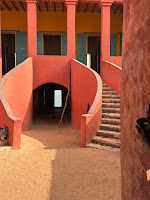The Maison des Esclaves' Door of No Return
I don't know what I was expecting; I guess I knew it would be a really tough experience. Ironically, we had to take a boat ride to Gorée Island, the place where, for slaves, it would be their place of no return; that irony was not lost on me. It was a somber ride to the island, and we were greeted by a heart statue and a few women vendors whose businesses weren't yet open with a request and promise to visit and purchase when they did open. Although I was grateful to be traveling with a group, this was the one time that I really wished I had been able to experience this in isolation.
We had a guide, by American standards, a docent, who walked us through the experience in the reconstructed museum. Le Maison des Esclaves was a holding center for enslaved African people to be exported. It was owned by an African French woman who also owned several slave ships and was active in the slave trade. I tried to imagine the house's appearance while it was used for the intended purpose. The small airless rooms, no bigger than 5' x 5' jammed packed with hundreds of enslaved Africans who were shackled and unable to move for days. The men, women, and children were in separate rooms with no light. The young girls were paraded in the courtyard for the slave traders to select the ones they would like to rape. I closed my eyes and envisioned the sounds and smells of the unfortunate souls who landed here. The tears came fast and in abundance. Our guide told us the slave traders lived above the rooms, could hear the moans and cries from the captives, and used them for entertainment while they waited for the slave boats to arrive.
There was a large room with a tub of water, which was added as part of the museum. Today, you are invited to stir the water and call out the names of your ancestors who are no longer with us. I called out my parents by name: my BFF from elementary school, Janet Allen; my beloved line sister (my Back), Delinda Faith Phillips Mack; and many others that came to mind in the moment. It was surreal. I could feel them gathering and laying hands on me. I cried, laughed, and closed my eyes in prayer. I wanted to know if they had spoken with anyone who had experienced this slave trade process and what did they learn. I could almost hear them tell me, "They fought the good fight."The guide shared that the strong and tall men and more robust women were sent to the United States, and the small-statured men and women were sent to be slaves for the French who had come to colonize West Africa. He noted that it explains the slender build of the men in Senegal versus the men in the United States; I noticed he didn't touch the subject of the size of women. It made me chuckle. Yet, I found his overview and insights carefully crafted to not anger the Black Americans touring the facility. His story was very mild, almost unbelievably peaceful, notwithstanding the horrible nature of the acts that had to happen.
At the end of the tour, our docent guide turned us over to another gentleman who gave us an unabridged overview of the history of the Gorée Island House of Slaves. His version was more believable. He stated that many of the slaves died of illness while in captivity, while others jumped from the boat into the ocean. Our new guide estimated that 200 to 300 slaves each year were processed through the Gorée between 1670 and 1810 (140 years). Some would argue this level of trade is insignificant in the grand scheme of the overall slave trade. My thoughts are it isn't the numbers that are most important; it is the fact that this level of inhumanity could occur at all--even for ONE PERSON, it is one too many.As I looked out of the door of no return, I wept for my ancestors who had no choice. I thought about the people, my Sept, that I've met on my journey so far, and I'm so proud of their joie de vivre despite their abject poverty. This will take some time to unpack. It is one thing to see movies, read books, or hear tales; quite another to physically see evidence of one of the greatest atrocities that has ever happened to my ancestors. These are my photos. I saw these images up close, and my heart hurts from all the life experiences I take for granted. I not only want to be present every moment of my life going forward, I also want to be grateful for every experience and gift that life brings.
It will take me some time to truly unpack this experience and I pray when I do, it is something that I can share with gratitude and joy because I get to live to see that day, form words to share, and know people with whom I love that I can share this experience.





Comments
Post a Comment